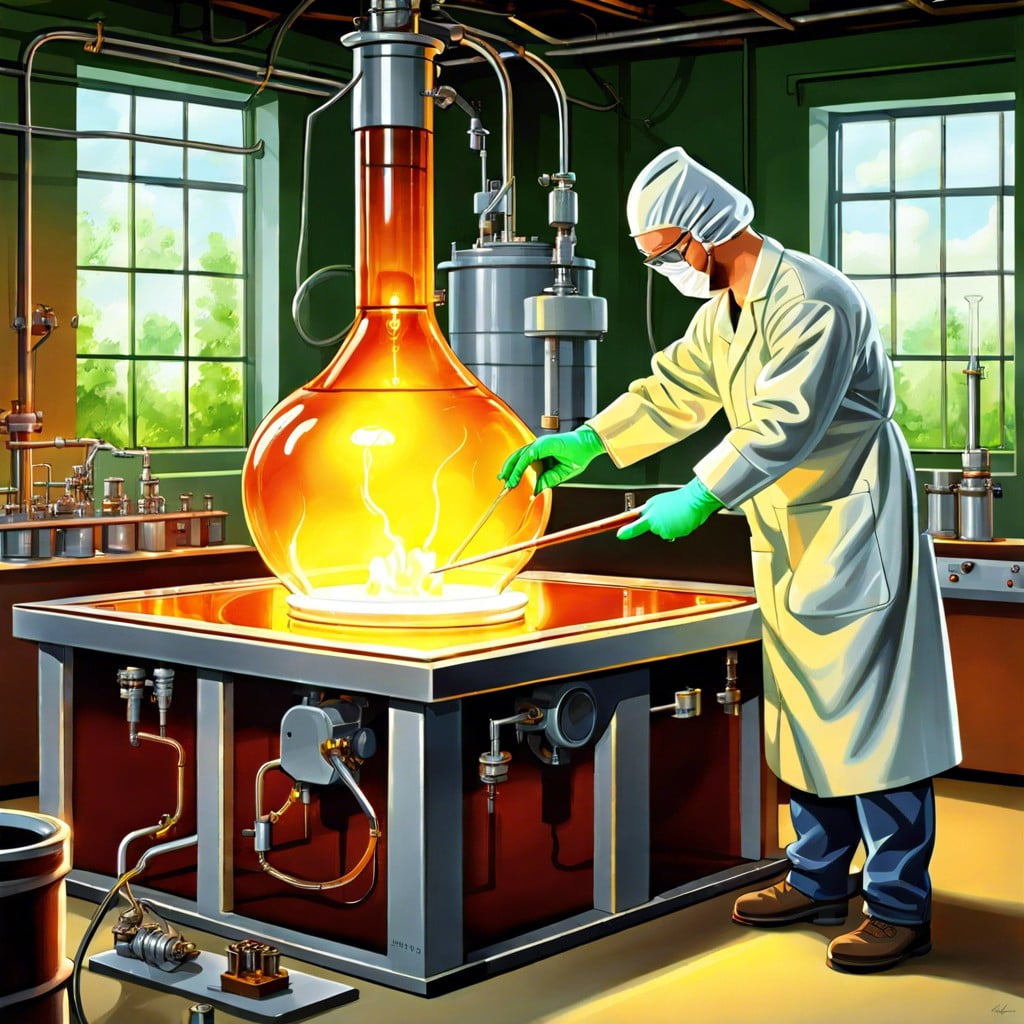Last updated on
Unraveling the mysteries of plutonium glass becomes an essential endeavour because its unique properties and applications have an intriguing and impactful past, fascinating uses, and vital safety considerations everyone should know.
Key takeaways:
- Plutonium glass is created by incorporating plutonium oxide into a glass matrix.
- Plutonium glass exhibits a greenish hue due to the interaction between plutonium ions and the glass matrix.
- Plutonium glass is used in smoke detectors and radioisotope thermoelectric generators (RTGs).
- Health risks associated with plutonium glass include increased cancer risk and radiation-related illnesses.
- Strict regulations and safety measures govern the storage, handling, and disposal of plutonium glass.
Production of Plutonium Glass

Plutonium glass is synthesized by incorporating plutonium oxide into a glass matrix, a process designed to stabilize and contain the radioactive element. High-temperature melting techniques are employed to ensure the plutonium is evenly distributed within a silicate glass composite. This immobilizes the plutonium, effectively isolating it from the environment and reducing the risk of contamination.
During production, the mixture is carefully controlled to maintain the integrity of the glass and to avoid any phase separation that could compromise the material’s containment properties. The resulting product has a characteristic dark hue due to the presence of plutonium.
The vitrification process is not only critical for immobilizing plutonium for long-term storage but also facilitates the management of nuclear waste. It is usually carried out in specialized facilities that are equipped to handle the safety concerns associated with working with radioactive materials.
Appearance of Plutonium Glass

Plutonium glass typically exhibits a greenish hue, a feature resulting from the interaction between plutonium ions and the glass matrix. This distinctive color can vary in intensity depending on the concentration and oxidation state of plutonium within the glass mixture.
On the molecular level, the unique coloration arises from the f-electron transitions of the plutonium atoms when light is absorbed and emitted, a similar process to that giving color to gems and minerals. Moreover, the homogeneity of plutonium distribution affects the opacity of the glass; with uniform dispersion, the glass appears clearer, while agglomerations or uneven distribution can lead to cloudiness or streaks, providing visual cues to the quality of the glass composite.
Fabrication Process
The creation of plutonium glass begins by blending plutonium with a silicate material, typically consisting of silicon dioxide. This process occurs within a controlled environment to ensure the utmost safety and precision.
During the heating stage, the mixture is brought to high temperatures, causing the plutonium to be suspended within the molten silicate. This high-temperature procedure not only encapsulates the radioactive particles but also changes the physical structure of the silicate, forming a solid matrix upon cooling.
The result is a dense, inert glass that immobilizes the plutonium atoms, effectively containing the radioactive material and making it more stable and manageable for transport or storage.
As the mixture cools, the rate of cooling is meticulously regulated to avoid the formation of cracks or imperfections that could compromise the integrity of the material. Once solidified, the plutonium glass is subject to rigorous testing to confirm that the dispersion of plutonium is uniform and that the final product meets the critical safety standards required for its intended use.
Usage in Scientific Equipment
Plutonium glass is a critical component in several scientific applications, primarily due to its radioactive properties. It is often utilized as the ionization source in smoke detectors, leveraging its alpha particle emissions to detect smoke particles. Additionally, because of its ability to sustain a constant rate of alpha emission over extended periods, it is used in radioisotope thermoelectric generators (RTGs), which power space probes and unmanned remote installations.
In research contexts, small amounts of this glass can be found in certain types of equipment used for neutron and alpha spectroscopy. It is a valuable calibration material for instruments that measure high levels of radiation and for experiments where a stable radiation source is required.
The use of plutonium glass within such equipment mandates stringent safety protocols to protect users from radiation exposure and prevent environmental contamination. The housing for this glass in equipment is typically designed with robust shielding, while the handling protocols require specialized training and protective gear.
Given its role in these sensitive applications, plutonium glass continues to be an indispensable material in both applied and pure research fields, where precise measurement and long-term energy sources are imperative.
Health Concerns Associated With Plutonium Glass
Plutonium glass contains radioactive elements that can pose significant health risks if not handled correctly. Exposure to radiation from this material can increase the risk of cancer, particularly if inhaled or ingested. This risk is due to the alpha particles emitted by plutonium isotopes, which can cause severe damage to living tissue and DNA.
Moreover, the external exposure to beta particles and gamma rays from plutonium glass can lead to radiation burns or acute radiation sickness, although these effects are less likely due to the glass’s encapsulating property. Therefore, it is crucial to follow rigorous safety protocols, such as using protective gear and working in well-ventilated areas, to minimize potential health impacts.
It’s also important for individuals working with or around plutonium glass to undergo regular health check-ups to monitor for any signs of radiation-induced illnesses. Robust safety training is essential to ensure all personnel understand the risks and the importance of adhering to safety guidelines to protect their health.
Estimates of the Radiation Exposures
Radiation exposure from plutonium glass must be diligently monitored and estimated to ensure the safety of individuals handling or in proximity to the material. Plutonium, being a radioactive element, decays over time, emitting alpha particles which are a significant radiation hazard if internalized.
Here are a few key points regarding radiation exposure estimation:
- Estimations rely on the specific activity of the plutonium isotope used; for instance, Pu-238, Pu-239, and Pu-240 have different half-lives and consequently different levels of radioactivity.
- The duration of exposure is a critical factor; short-term contact with plutonium glass might not pose significant risks, but cumulative exposure can lead to higher levels of radiation absorption.
- Distance from the source greatly affects exposure levels; radiation intensity decreases with the square of the distance, so maintaining a safe distance is effective for reducing exposure.
- The use of shielding can drastically reduce exposure; materials like lead glass or acrylic are often used to contain radiation and protect users.
- Personal protective equipment (PPE) such as gloves, lab coats, and respiratory protection help prevent ingestion or inhalation of radioactive particles.
- Monitoring involves the use of radiation detection equipment like alpha spectrometry or gamma spectroscopy to measure levels of radiation and ensure they are below established safety thresholds.
- Professional assessment through dosimetry, where the accumulated radiation dose received by an individual is calculated, supports the establishment of safety protocols and exposure records for health monitoring.
Each of these factors contributes to a more accurate approximation of the radiation dose incurred during the handling of plutonium glass, which is crucial for maintaining occupational safety and regulatory compliance.
Pertinent Regulations and Safety Measures
In handling and storing plutonium glass, adherence to stringent regulatory guidelines is pivotal to ensure the health and safety of individuals and the environment. These regulations are governed by international bodies, such as the International Atomic Energy Agency (IAEA), and national organizations, including the United States Nuclear Regulatory Commission (NRC) and the Environmental Protection Agency (EPA).
Key considerations include:
- Licensing Requirements: Facilities dealing with plutonium glass must obtain necessary licenses, demonstrating robust safety protocols and emergency preparedness plans.
- Radiation Protection: Standards for radiation exposure limits are set to protect workers and the public. These are based on the principles of justification, optimization, and dose limitation.
- Transportation Protocols: Transport of radioactive materials must comply with regulations regarding packaging, labeling, and carriage to minimize risks during transit.
- Operational Safety: Continuous assessment of work practices to prevent accidents, including the implementation of safety barriers and containment measures.
- Personnel Training: Employees must receive comprehensive training on handling procedures, risks associated with radiation, and steps to take in an emergency scenario.
- Environmental Surveillance: Monitoring of air, water, and soil quality in and around facilities to detect any potential contamination.
- Waste Management: Clear protocols for the safe disposal or recycling of plutonium glass, including storage, treatment, and final disposition.
By maintaining compliance with these measures, facilities help to safeguard both workers and the surrounding communities from potential hazards associated with plutonium glass.
Storage & Handling of Plutonium Glass
The storage and handling of materials containing plutonium are subject to stringent protocols to mitigate health risks and prevent environmental contamination. To ensure safety, several key principles must be observed:
1. Containment: Plutonium glass should be stored in high-integrity containers made from materials that resist radiation damage and chemical corrosion, thus preventing the spread of radioactive particles.
2. Shielding: Given plutonium’s emission of high-energy alpha particles, storage containers often include a layer of dense materials like lead, which effectively absorbs and stops radiation, thereby protecting handlers.
3. Controlled Access: Access to storage areas is restricted to authorized personnel only, with secure access systems in place to prevent unauthorized entry and potential security breaches.
4. Inventory Management: A rigorous inventory system is essential to track quantities, locations, and movements of plutonium glass to ensure that all materials are accounted for, reducing the risk of loss or theft.
5. Safety Training: Handlers receive specialized training in radiological safety, proper use of personal protective equipment (PPE), and procedures for emergencies, such as containment breaches or exposure incidents.
6. Transportation: When transport is necessary, it is carried out using certified transportation casks designed to withstand extreme conditions without leaking or compromising the radioactive content.
7. Monitoring: Regular monitoring for contamination includes swipe tests and the use of radiation detectors to ensure that neither the storage containers nor the surrounding areas become sources of exposure.
By adhering to these practices, the risks associated with plutonium glass can be managed effectively to safeguard workers and the environment.
Disposal and Recycling of Plutonium Glass
Handling and disposing of materials containing plutonium, such as plutonium glass, present unique challenges due to their radioactive nature. The process necessitates strict adherence to regulatory guidelines and protocols to ensure environmental and public safety.
Firstly, disposal of such materials typically requires coordination with government agencies responsible for nuclear safety and environmental protection. They are not discarded through conventional means due to their hazardous nature.
Secondly, these materials must be stored in secure facilities designed to isolate the radioactive elements from the environment. This is done to prevent any potential leaks or contamination. The facilities are engineered to withstand natural disasters, ensuring long-term containment.
In terms of recycling, traditional recycling methods are not applicable to plutonium glass due to its radiotoxicity. However, research is ongoing to develop methods for reusing plutonium recovered from various sources, including glass, in a closed fuel cycle for nuclear reactors. This is intended to minimize waste and make better use of nuclear materials.
Finally, it’s important to note that the ultimate decision on the disposal or recycling of plutonium glass is governed by national and international standards aimed at safeguarding both human health and the environment. These decisions are based on rigorous scientific analysis and are subject to regular review as technology and methodologies advance.
References On Plutonium Glass Studies
Exploration into plutonium glass encompasses a significant span of detailed research, contributed by respected institutions and government facilities due to the material’s complex nature and the need for stringent safety protocols.
Key studies often referenced include those from the Lawrence Livermore National Laboratory, which investigate the material’s stability and long-term viability for waste storage. The U.S. Department of Energy’s Office of Scientific and Technical Information provides a repository of published works pertinent to nuclear materials, including plutonium glass.
Journals such as the “Journal of Nuclear Materials” offer peer-reviewed articles elaborating on the latest advancements in handling and characterization techniques. International Atomic Energy Agency (IAEA) documents serve as vital resources for global safety standards and the management practices surrounding radioactive materials.
Publications from universities with strong nuclear engineering programs, like MIT and the University of California, Berkeley, may also provide cutting-edge research and comprehensive reviews on the compound’s chemical dynamics and its role in environmental science.
Those seeking an in-depth understanding of plutonium glass are encouraged to look into these repositories and journals for the most authoritative and current information in the field.




